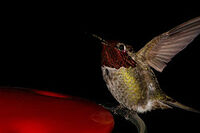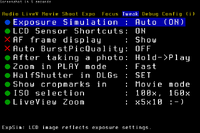... for Canon 550D, 60D, 600D, 500D and 50D
Magic Lantern pre0.2.2 -- User's Guide
English | Česky | Deutsch | Dutch | Español | Français | Italiano | Română | Русский | 简体中文 | 日本語
Features
- Audio: disable AGC and digital filters, audio meters, manual audio controls, selectable input source (internal, internal+external, external stereo, balanced), audio monitoring via USB.
- Exposure helpers: zebras, false color, histogram, waveform, spotmeter.
- Focus tools: focus peaking, zoom while recording, trap focus, rack focus, follow focus, focus stacking, zoom in Face Detect mode.
- Movie helpers: Bitrate control (QScale or CBR), movie logging (Exif-like metadata), auto-restart after buffer overflow or 4 GB limit, clean LiveView display without any overlays, change movie position on the mode dial.
- Cropmark images: user-editable overlays to assist framing and composition.
- Fine control for ISO, Shutter, Kelvin white balance and other image settings.
- Remote release with LCD face sensor and audio trigger, without extra hardware.
- Bracketing: exposure bracketing, focus stacking.
- Timelapse: intervalometer (for photos and movies), silent pictures without shutter actuation.
- Astro- and night photography: bulb timer for very long exposures (up to 8h).
- Info displays: focus and DOF info, CMOS temperature, shutter count, clock.
- For strobists: flash exposure compensation, range up to -5 to +3 EV (depends on the camera).
- Power saving: Turn off display or reduce backlight in LiveView during idle times.
- Fun stuff: slit-scan pictures.
Important notes
- If you have a bootable SD card and have the BOOTDISK flag set in the camera (which the installer does), and you do not have an AUTOEXEC.BIN file on the card the camera WILL NOT BOOT! It will hang and not wake up until the battery is removed.
- If you encounter a "locked up" camera, quickly remove the battery.
- When in doubt, remove the battery and reboot.
- And, remember that this software can damage or destroy your camera.
FAQ
Does Magic Lantern completely replace Canon firmware?
No. Magic Lantern runs from the card, as an add-on over standard firmware. You will still be able to access all Canon functionality.
To go back to Canon firmware, you may:
- Press and hold SET at startup to bypass ML only once (for the current session).
- Format your card in the camera and choose to remove Magic Lantern.
- Disable the bootflag (this will uninstall ML from the camera; to do this, run Firmware Upgrade and follow the instructions).
How do I erase all of the images without removing ML?
Canon menu -> Format -> Format card, keep Magic Lantern.
How do I record for more than 12 minutes?
- Lower the bitrate (CBR 0.4 will let you record continuously for 30 minutes).
- Use Movie restart, but you will lose a few seconds when a new file is created.
- To record continuously for more than 30 minutes, you need to use a HDMI recorder. Select Clear Overlays: Always to hide all graphical overlays and enable Half-press shutter: Every second to prevent the camera from shutting down.
Technically, there's no 12 minute limit. There's a 30 minute limit and a 4 GB limit, whichever comes first. With default bitrate settings, the 4 GB limit is reached after around 12 minutes (more or less).
How do I get exposure times longer than 30 seconds?
You may use:
- Bulb timer (for a single photo).
- HDR bracketing in manual mode.
- Bulb ramping (for timelapse).
How do I see shutter counter / CMOS temperature?how la
Look in Debug menu.
Does ML eat batteries faster, or cause overheating?
No. Even with zebras and focus peaking active, the power draw only increases by 5%, compared to standard firmware. You can do your own tests if you have a 60D.
Magic Lantern can reduce power consumption by dimming or turning off the LCD screen, or by pausing LiveView without moving the mirror. See Power saving for details.
Tip: batteries are not expensive; however, third-party models may last less than original Canon batteries. See this topic.
Does ML do any persistent changes to my camera?
Yes. Besides the bootflag (which is required for auto-boot), there are a number of other changes which are saved into NVRAM. These are:
- ISO, shutter, aperture, white balance;
- Exposure compensation, drive mode;
- Picture style and associated parameters;
- Flash settings (enabled/disabled, exposure compensation, red eye reduction);
- AF points, AF mode in LiveView, focus box position;
- Exposure simulation setting (in Expo menu; disabled temporarily when using 5x/10x zoom modes);
- Backlight level (for example, it's lowered temporarily if you use Dim display for power saving);
- Autofocus is moved temporarily to back (*) button whenever ML has to take a picture without autofocusing. This includes HDR bracketing and bulb exposures.
- Autofocus is moved temporarily to half-shutter when you use AF patterns, while changing the AF point;
- Sound recording is disabled temporarily when you use FPS override;
- On 600D, video mode may be changed via ML shortcut key;
- On 60D, INFO button function may be changed if you enable DispOFF in photo mode;
- On 50D, movie recording function is changed from ML menu (yes, this is a persistent Canon setting, but it's not present in Canon menus).
With few exceptions, these settings can also be changed from Canon menus or controls.
A few settings are changed temporarily during certain operations (for example, autofocus for bracketed shots), but these settings are saved by Canon firmware in NVRAM. If you take the battery out in the middle of the operation (for example, in the middle of taking a picture), ML won't be able to restore these settings back to your initial values, and you'll have to change them back from Canon menus.
To the best of our knowledge, all these settings are restored to default values when you run "Clear camera settings" and "Clear custom functions" from Canon menu.
All persistent changes can be seen in ML source code by examining the calls to prop_request_change. Some of the changes are not persistent (for example, LiveView zooming), and they were not included in the above list.
Why the audio is so quiet / noisy after disabling AGC?
You will have to adjust the volume manually; use the audio meters to determine the proper level.
Best audio is obtained by use of a preamp system fed to the camera. As a general rule, the use of a quiet preamp to send the signal to the camera will result in better the sound recorded in camera. Use of a preamped XLR adapter like the JuicedLink CX231 or a field mixer will give superior results. You may also use a recorder like Zoom H1, H2 or H4n, but since the line out level is much higher than the mic level, you will have to turn the output down from your recorder or use a pad cable.
For more info, check out the Canon DSLR Audio thread on dvxuser and AGC Disable - Magic Lantern vs. Juicedlink? on dvinfo.
Why does the camera take pictures when pressing the shutter half-way?
Trap focus may be active.
My camera freezes / I get ERR70/80/99 / I get corrupted files. Why?
- Format your card. Some of these problems are caused by filesystem corruption or cheap card readers. Always use the safe removal feature before you unplug your card from your computer.
- Run the stability test from the Debug menu. If it fails, upgrade Magic Lantern and run the test again.
- If you still have problems, report an issue.
What about ERR20 when taking pictures?
This problem is not related to (or caused by) Magic Lantern.
You will get this error when your shutter mechanism no longer works properly. Contact your Canon service center.
Consider entering your shutter count in the Camera Shutter Life Database.
Why feature X doesn't work properly?
- Read the manual. In many cases you will find the solution.
- Try upgrading to the latest build. In some cases, downgrading to an earlier build will also help.
- Search the Vimeo ML user group, the issue tracker and the mailing list.
- If you still have problems, report an issue (if you've found a bug) or ask on the forums.
Known issues
- First second of recorded audio may be very loud.
- Sometimes, rack & stack focus simply refuse to work, and you need to restart your camera.
- SD monitors are NOT supported. Image format is not YUV422 (unlike with built-in LCD display and HDMI).
- Not all ML features are available on all compatible cameras (go to Unified/Features to see what works on each camera).
Key shortcuts
PLAY mode shortcuts
- Q (550D), UNLOCK (60D), DISP (600D) or FUNC (50D): show exposure tools (zebra, false color, histogram, waveform, spotmeter) and cropmarks (as configured from LiveV menu).
- LV: create a transparent overlay from current image (when Ghost Image is active). You can use it for panoramas or for repeating shots.
- SET + Main Dial (Wheel) in PLAY mode: see SET+MainDial.
- MENU: open ML playback menu.
LCD sensor shortcuts
This feature is only available on 550D and 500D.
LCD sensor can be used as a simple remote (see LCDsensor Remote ), as a simple wireless follow focus, or as shift key (see also SensorShortcuts option).
- LCD sensor + UP / DOWN: adjust LCD backlight level.
- LCD sensor + LEFT / RIGHT in LiveView: adjust audio gain (volume for recording).
- LCD sensor + Arrows: see Follow Focus.
- LCD sensor + Zoom In: activates Magic Zoom.
Flash/Disp button shortcuts
This feature is only available on 550D (Flash button in Movie mode) and 600D (DISP button).
- Flash/Disp (short press): change current display preset.
- Flash/Disp + UP / DOWN in Movie mode: adjust Kelvin white balance.
- Flash/Disp + LEFT / RIGHT in Movie mode: adjust ISO.
Misc shortcuts
- SET pressed at startup: loads vanilla firmware (does not load Magic Lantern).
- ISO -> LV: switch to Movie mode (from photo mode). To switch back to photo mode, you need to turn the mode dial back and forth one notch.
- ISO -> DISP (550D) / ISO -> INFO (600D) / Metering (60D): change current display preset.
- Zoom In while recording: it does just that :) (Magic Zoom)
- MENU while recording will clear the screen and force a redraw of ML elements.
- SET in LiveView: center AF area (the little rectangle).
- Q followed by SET, while ISO speed dialog is active: go to ISO item in ML menu.
- Activating AF mode dialog when Manual Focus is active will toggle Trap Focus.
- Press ERASE button (exception: Picture Style on 50D) to bring up the Magic Lantern menu.
- Use arrow keys, joystick or scrollwheels to navigate.
- Use SET and PLAY to toggle values.
- Use Q to open a submenu with more settings.
- Press INFO or DISP button to get help.
- Press MENU to display the advanced menu.
- In LiveView, press Zoom In to display LiveView behind ML menu.
For cameras without Q:
- 5D Mark II: press the Picture Style button.
- 50D: press the FUNC button.
- 500D: press the LiveView button.
Audio
200px|right|Audio tests by Ryan Sauvé 200px|right 200px|right
Manual audio controls.
This menu is only available on 550D/T2i and 60D.
The 600D/T3i already has manual audio control, but right now it's not possible to change audio settings from Magic Lantern. You can only use audio meters during recording.
Audio Meters: ON / OFF
-
Self-explaining. Audio meters are only displayed in movie mode.
Audio level scale is from -40dB to 0dB; meters become yellow at -12 dB and red at -3 dB.
Analog Gain (dB)
- Gain applied to both inputs in the analog domain. If you use an external preamp, set this parameter as low as possible; otherwise, set it as high as possible without clipping (audio meters should be green).
L-DigitalGain and R-DigitalGain (dB)
- Digital gain applied to left and right channel. Recommended setting: 0.
AGC: ON/OFF
-
Enable/disable Automatic Gain Control. AGC is applied only in digital domain (i.e. it overrides digital gains, but you can still adjust analog gain).
Recommended setting: OFF.
Input source
-
Audio input source for recording:
- internal mic
- L:int R:ext
- external stereo
- L:int R:balanced (internal mic on Left, external mic on Right from both external pins as balanced audio)
- Auto int/ext: camera detects if a mic is plugged in. Int is dual mono, ext is stereo.
"Balanced audio allows for very long cable runs without interference. Usually balanced mics have three pin XLR connectors and it is very easy to out together an XLR to Canon mic input cable. Balanced allows us to use such pro mics with our little Canons and this is a very welcome surprise for audio guys." (source)
Mic Power: ON/OFF
-
This is required for internal mic and certain types of external mics, but it reduces input impedance. See AK4646 datasheet p.31 and the Mic power control thread.
- ON: input impedance is 2 kOhm
- OFF: input impedance is 30 kOhm
Headphone Monitoring: ON/OFF
-
200px|right
Audio monitoring with headphones, via USB port.
Disable this setting if you are using a SD monitor!
This feature is not available on 600D/T3i.
To use audio monitoring, you need a special cable:
- your Canon USB - RCA cable with a RCA - 3.5mm jack adapter
- a dedicated cable from Sescom
- or you may solder it yourself (you will have to cut the USB-RCA cable).
For details, see Audio monitoring HOWTO on Vimeo group.
Output volume (dB)
-
Digital output gain for audio monitoring. It does not have an effect on the internal camera speaker.
For best results, you should a pair of low impedance headphones, for example Audio Technica ATH-M50 (38 ohms). With high-impedance headphones, you may have to use a headphone amplifier like FiiO E5.
LiveV
LiveView overlays: histogram, zebras, cropmarks, spotmeter, focus peaking, false color...
Global Draw: ON/OFF
-
Enable/disable drawing extra graphics elements (zebra, cropmarks, histogram, waveform, false color, spotmeter, audio meters, ML shooting info...).
Tip: use this setting to quickly turn them off.
Histogram
Waveform
-
200px|right
These exposure tools display the distribution of image brightness levels.
To learn how to read these graphs, see Understanding Histograms and Final Cut Waveform Monitor.
Tip: if you shoot RAW, use the UniWB method to get a good approximation of RAW RGB histogram. To setup UniWB, do a custom white balance on a completely overexposed image (100% white), set the picture style to Neutral 0,-4,-4,0 and disable Peripheral Illumination Correction.
Vectorscope
-
This tool shows the color distribution with an U-V plot. Useful for color grading.
To learn how to read it, see Introducing Color Scopes: The Vectorscope.
Zebras
-
Enable/disable zebra stripes, which indicate overexposed or underexposed areas.
Color spaces:
- Luma: zebras are computed from Y channel only.
- RGB: check overexposure for each RGB channel. Clipped channels are displayed in the opposite color (i.e. clipped red shown as cyan, underexposed as white and so on). For RAW RGB zebras, use the UniWB method (see Histogram for details).
You may adjust thresholds for underexposure and overexposure.
Note: when using the Technicolor CineStyle picture style, luma will have values between 16 and 255; therefore, you will have to set the underexposure threshold to 16 or greater.
False color
-
This is a tool for evaluating the exposure. It shows different luma (Y) levels using a color map. You may select one of the following color maps:
Tips:
- you may configure a display preset with False Color and toggle it with a single button press.
- you may also use false colors highlight 50% and 70% brightness, to reveal color banding or to check for uniform green screen lighting.
Cropmarks
-
200px|right
Cropmarks or custom grids for framing and composition.
Notes:
- If you use custom cropmarks, place them in CROPMKS folder on your SD card and give them short 8.3 names. You can place at most 9 cropmarks on the card.
- Get more cropmarks from the ML cropmark repository or draw your own (see Cropmarks).
Ghost image: ON/OFF
-
Shows a transparent overlay which can be created from any image in Play mode.
Usage:
- To select the image, go to Play mode and press the LiveView button.
- Move the ghost image in LiveView with arrow keys; center or hide it with SET.
Defishing: ON/OFF
-
Preview the rectified (defished) image from Samyang 8mm fisheye lens, using rectilinear projection.
Tip: in PLAY mode it's colored.
Defishing is computed with a LUT, from LiveView image buffer. It is possible to create LUT files for any other lens or projection by defishing vram/xy.png with your favorite defishing software, and then running vram/defish-lut.m to get the LUT file. All the required files are found in the ML source tree. Project files (*.PTO) for nona (hugin) are provided for both rectilinear and Panini projections.
Spotmeter: OFF / Percent / IRE
-
Measure brightness from a small spot in the frame.
Possible measurement units:
-
- Percent (0..100%)
- Raw 8-bit levels (0..255)
- IRE -1..101 (formula used by AJ, which maps 0-255 brightness levels to approx. -1..101 IRE)
- IRE 0..108 (formula proposed by Piers, which maps 16-235 brightness levels to 7.5-100 IRE)
-
Clear Overlays
-
Clear bitmap overlays from LiveView display.
HalfShutter: Hold the shutter half-pressed, or the * button, or DOF preview for around 1 second to clear all the overlays from the Live View display (audio, zebra, crops, shutter speeds...).
Tip: assign autofocus to * button (from Custom Functions, set Shutter/AE lock button = AE lock/AF).
WhenIdle: In this mode, all the overlays are erased from the screen (100% clean display) when the camera is idle (i.e. you don't press any buttons).
Always: In this mode, all the overlays are erased from the screen; you will have to change shooting settings blindly. You can still use the menus.
Tip: this feature may be useful with External Recorders, since it removes the focus box and other graphics from the display.
Focus Peak
-
200px|right
Focus assist function. High-contrast lines will be marked by blinking dots showing which part of the image is in focus.
Methods:
-
- D1xy: computes first image derivative on X and Y and takes the max value.
- D2xy: approximates second image derivative with a 3x3 Laplacian kernel.
Other parameters:
-
- Threshold: how many pixels are considered in focus (percentage).
- Color: either fixed color, or a color coding according to focus intensity.
To see how it works, check this article from Luminous Landscape..
-
Magic Zoom
-
200px|right
Displays a zoom box for focus assist. Can be used while recording.
Trigger modes:
- Zoom.REC: triggered by Zoom In button pressed while recording. If your camera has a LCD sensor, you may also cover it and press Zoom In.
- ZREC+Focus: triggered by turning the focus ring (only on lenses which report Focus distance, or with follow focus / rack focus). You may still trigger it with Zoom In while recording.
- Zoom In (*): triggered by Zoom In button (overrides Canon's default zoom modes). To bypass magic zoom, press both zoom buttons at the same time or cover the LCD sensor.
- Always On. You can use both Canon's 5x/10x zoom and Magic Zoom.
- Green Bars
- Split Screen: when the image is out of focus, the zoom box looks like a split focusing screen from old film cameras.
- Split Screen with ZeroCross: will reverse the split direction whenever you achieve perfect focus.
Notes:
- Zebras, focus peaking and false color are disabled automatically when the zoom overlay is active.
- Half-pressing the shutter will temporarily hide the zoom overlay.
Movie
Functions specific to movie mode.
Bit Rate: CBR, 0.1x ... 3x
-
Controls H.264 bitrate used for video recording.
Possible modes:
- CBR: constant bitrate. You specify a factor for multiplying default video bitrate, between 0.1x and 3x. CBR 1x is the firmware default setting.
Bitrate Test - Used Magic Lantern and Canon 600D-0
- QScale: constant quality, variable bitrate (VBR). Available values: -16 ... +16. Lower numbers mean higher bitrates.
- Firmware default: completely disable bitrate control.
Notes:
- Increasing the bitrate may cause recording to stop. You need a fast card.
- CBR actually works by adjusting QScale on the fly; the instant value is displayed near the recording dot.
- In QScale mode, bitrate is completely out of control (don't use it!).
- In CBR mode, QScale will not go outside [-16...+16]. In this case, bitrate will be different than your CBR setting. Watch the bitrate indicators.
- You can push the bitrate higher if you record without sound, then use Audio RemoteShot to sync the video with an external audio track.
- You can't change this setting during recording.
- A red X means Magic Lantern did not make any changes to bitrate settings.
- If buffer usage gets too high, ML will pause all CPU-intensive graphics. Change the BuffWarnLevel setting to customize this.
See Bit rate page for details.
Time Indicator: OFF / Elapsed / Remain.Card / Remain.4GB
-
When recording a movie, ML will display a small time counter in the upper right corner, which can be:
- Elapsed: duration of the current clip
- Remain.Card: estimated amount of recording time remaining on the card.
- Remain.4GB: estimated amount of recording time until reaching 4GB (or until filling the card, whichever comes first).
Movie Restart: ON/OFF
- While this setting is on, movie recording will restart automatically, unless stopped by you. There will be a few seconds skipped during restarting.
Movie logging: ON/OFF
-
If this setting is ON, Magic Lantern will write out a metadata file for the each movie to MVI_1234.LOG (numbered after the movie). The log file contains lens and exposure info, as well as a timestamp every time any of the parameters is changed during recording.
Log files are placed in the same folder as the movies: DCIM/100CANON/, 101CANON etc.
Tip: you can rename LOG files to CSV and import them in MS Excel.
MovieModeRemap: A-DEP / CA / C
-
Changes movie position on the mode dial. You can swap movie mode with either A-DEP, CA or C.
Alternative: press ISO and then press LV.
Movie REC key: Default / HalfShutter
- This option enables you to start/stop movie recording by half-pressing the shutter button.
Shutter Lock: ON/OFF
- This option locks the shutter value in movie mode (you will be able to change it only from ML menu).
REC/STBY notify
-
Custom notifications for recording or standby:
- Red Crossout (highly recommended if you forget to press record)
- Message (it shows STBY or REC)
- Beeps (it will beep when recording starts or stops)
DigitalZoom Shortcut: 1x,3x / 3x...10x
-
On 600D/T3i, this lets you customize the behavior of DISP + Zoom In / Zoom Out shortcut key in movie mode:
- 1x,3x : toggle between 1x and 3x digital zoom modes (FullHD)
- 3x...10x: default Canon setting (change digital zoom value between 3x and 10x).
Force LiveView: OFF / Start & CPU lenses / Always
-
Force LiveView in Movie mode (bypass the dialog saying Press LV button to activate movie shooting).
- Always: force LiveView even if you use an unchipped lens, or no lens at all. Be careful, you may get dust on the sensor while changing lenses.
- Start & CPU lenses: it will force LiveView at startup, regardless of the lens used. After this, it will only bypass the dialog when a chipped lens is attached (i.e. it will enter LiveView as soon as you attach a chipped lens).
Movie Record: ON/OFF (50D only)
-
Enable movie recording on 50D (1920x1080, 30fps, without sound). To start recording, go to LiveView (P/Tv/Av/M) and press SET.
WARNING
Canon 50D was NOT designed to record movies. Keep in mind:
- This feature was not thoroughly tested and may be unstable.
- Always disable movie recording when you don't use it.
- Battery will drain quickly when recording; also, the camera may overheat.
- The camera will not record sound. You can use an external recorder (for example, Zoom H1, H2 or H4n) and sync the sound in post with a clapperboard.
- You can't play back movies in the camera.
Exposure Lock: ON/OFF (50D only)
- Locks the exposure in movie mode. You can also use the * button (you don't have to hold it pressed).
Shutter Button (50D only)
-
- Leave unchanged: obvious :)
- Block during REC: blocks the shutter and related (AF, *) buttons while recording. In 50D, taking pictures while recording would result in ERR99; with this option, you can avoid taking pictures while recording by mistake. Side effect: this will disable image stabilization during recording.
- Hold during REC (IS): ML will keep the shutter button pressed half-way during recording, which will enable image stabilization (IS). Side effect: you need to press the shutter button half way to turn IS off before the camera will let you stop recording.
FPS override
-
This setting alters FPS for all video modes. Only undercranking works well.
FPS is changed by altering two timer values (let's call them Timer A and Timer B). Increasing any of these values results in lower FPS.
Options:
- Desired FPS: choose a value from 0.2 fps to 65 fps. If the desired value is not possible, ML will choose the closest safe option (look at 'Actual FPS' below).
- Optimize for:
- Low FPS, 360d: use this option for recording timelapse with shutter speed set to 1/fps (360 degrees); at high FPS values, you may be able to use other shutter speed values.
- Exact FPS: try to achieve an exact FPS value, such as 24.000 or 30.000 or 12.500. If more solutions are found, ML will choose the one with lowest jello effect.
- LowJello, 180d: minimize the jello effect (caused by rolling shutter), while allowing you to expose at 180 degrees (0.5/fps) if possible.
- High Jello: maximize the jello effect and enable fast shutter speeds. You can use this mode for recording slit-scan frames (distorted images like these, which use the extreme jello effect in creative ways).
- Shutter range: displays the available shutter speed range with current settings. When you use FPS override, Canon menu will still display 1/30 ... 1/4000, but the actual shutter speed will be different; read it from ML displays. You can alter shutter speed range by changing the ratio between the two timer values (decreasing timer B will result in faster shutter speeds available).
- Timer A: displays the value of timer A and lets you fine-tune it. ML will re-adjust timer B to match your FPS choice.
- Timer B: displays the value of timer B and lets you fine-tune it. ML will not re-adjust timer A, so this option will let you fine-tune the exact FPS value.
- TG Frequency: displays the crystal oscillator frequency of the FPS circuit driver (read-only, depends on your camera).
- Actual FPS: this displays the current FPS, computed as TG_FREQ / timerA / timerB (read-only).
- Sound Record: by default, ML will disable sound recording when FPS override is enabled; otherwise, audio will go out of sync and recording will stop. Only enable sound if you know what you are doing.
This function will not change the frame rate from the video header; the video will playback at the setting from Canon menu.
Recommended usage: set FPS to a very low value (for example, 3fps) to record a timelapse.
To get 180-degree shutter speed at very low FPS, simply discard half of the frames in post.
If 0.2 FPS is not enough, use Frame Merger (a VirtualDub plugin).
Exact frame rate may be "rounded" to be an exact multiple of PAL/NTSC frame rates.
-
- PAL modes: 25p/50p. Rounded frame rates: 33.333fps, 12.5fps, 11.111fps and so on.
- NTSC modes: 30p/60p/24p. Rounded frame rates: 29.97fps, 23.976fps, 11.988fps and so on.
-
For fine-tuning and calibrating custom frame rates, use EOSTimerGen.
HDR video
-
200px|right
This feature allows you to shoot a high dynamic range video by alternating ISO every other frame. Select the two ISO values from the submenu.
On 500D, you may have to hold the shutter button halfway while shooting HDR video.
Discussion thread, postprocessing workflow, FAQ...
Shoot
Functions for stills shooting (some of them work for movies, too).
HDR Bracketing
-
AE Bracketing for HDR images and timelapses.
- In M mode, this function does shutter bracketing. In the other modes it does exposure compensation bracketing.
- To start bracketing, take the first picture and ML will continue the sequence.
- To preview HDR images in camera, set SET+MainDial: ExposureFusion from Play menu, then go to playback mode, hold SET and turn the main dial (wheel).
- For each HDR picture set, Magic Lantern also writes a bash script for stacking the exposures with enfuse (version 4.x). More info: Exposure Fusion: What is it? How does it Compare to HDR? How Do I Do It?.
Intervalometer: ON/OFF
-
200px|right 200px|right
Take pictures or movies at fixed intervals.
You can stop the intervalometer by rotating the mode dial.
Settings:
- Duration between two shots.
- Bulb ramping option (see below).
- In movie mode only: duration of a movie clip.
Tips:
- To avoid flicker, shoot in manual mode or use Bulb Ramping, use manual white balance, avoid short exposure times and use a manual lens (if you use an EF lens, lock the aperture and unscrew it).
- To make a timelapse without increasing shutter count, do not use the intervalometer; instead, set FPS override to a very low value (for example, 3fps) and start recording.
- When using the intervalometer in LiveView with "noisy" mode, your shutter will wear twice as fast than outside LiveView.
- If the intervalometer can't be stopped (it may happen in crazy mode), turn the camera off or open the card door.
Power Saving:
- When not in LiveView, press DISP or INFO to turn the display off.
- In LiveView, ML will turn the display and the sensor off during idle times if you enable this option from Powersave menu.
- While the intervalometer is running, the card led will blink once per second to let you know it's alive and kicking.
Bulb Ramping: ON/OFF
-
200px|right
Bulb Ramping allows the capture of a timelapse that gradually changes exposure, compensating for the transition from day to night.
This option will adjust shutter and ISO automatically, using the 180 degree rule.
Quick start:
1. Take a picture of your scene. You will use it to say: "I want my timelapse to be exposed like this picture".
2. Enable Bulb Ramping and Intervalometer.
3. Leave the camera still while ML runs a calibration step:
-
- Make sure you have a static and well-lit scene (any static scene which does not require long exposure should be fine).
- After calibration, you should get a nice S-curve on the screen.
4. Now you will have to say what tone range to meter for (i.e. highlights, midtones...). Follow the wizard:
-
- Use arrow keys to select your reference picture (which you just took).
- Use the main dial to select the tone range to meter for. You can't perfectly match two images just by varying one parameter (exposure), so you have to choose what's important for you in this picture.
- For lowest flicker, meter for midtones (choose the 50th percentile, i.e. median). Leave some headroom for highlights (underexpose a bit).
- If highlights are important, meter for them (choose 80th percentile for example). You will get more flicker; shoot RAW to remove it easier in post.
- The algorithm works best when brightness is close to 50% (try not to choose extreme values for it).
- When you are ready to start, press SET.
5. Sit back and relax :)
Limits:
-
- ISO is chosen between 100 and maximum auto ISO value from Canon menu.
- Shutter speed is chosen between 1/1000 (lower limit) and the delay between two shots minus two seconds (upper limit). Example: for 10-second intervals, shutter speed will be between 1/1000 and 8 seconds).
- Aperture is fixed (you can change it manually).
Tips:
- Don't adjust ISO and shutter before the timelapse, they are fully automatic.
- You can use this option with a HDR timelapse. In this case, when configuring the exposure parameters, choose the brightest picture in the HDR sequence (the last one).
- Use a ND filter to reduce flicker during daylight.
- Reduce flicker in post. You may try VirtualDub with MSU Deflicker plugin (free, works with Windows and Wine). See also Timelapse workflow using free software tutorial.
- The delay between two shots affects how ISO and shutter are chosen, according to 180 degree rule:
- For example, let's say you set "Take pics every 40 seconds"
- ML will try to set the shutter speed between 90 and 270 degrees. In our example, it will be chosen between 10 and 30 seconds if the light conditions allow it.
- If the scene is too bright or too dark, shutter will be chosen between 1/1000 (at ISO 100) and (d - 2) seconds (at max auto ISO, up to 6400), where d is the delay between two shots.
Techincal notes:- Exposure is adjusted using a condition like this (for example): 70% of pixels should be below 50% brightness.
- Exposure for every shot is computed from previous shot only (camera will go to Play mode for one second to compute the exposure from the histogram).
- ISO is chosen using the 180 degree rule, so the resulting shutter speed stays between 90 and 270 degrees (that is, between 1/4 and 3/4 of the delay between two shots).
- Only native ISOs (100, 200, 400 etc) are used, for best dynamic range.
- Shutter speed can be adjusted with a resolution of 10ms.
- Frames with fast shutter speeds (less than 1 second in Rebel cameras, less 0.1 seconds in 60D) are taken in Manual mode. You will get flicker.
- It can go from 1/1000s @ ISO 100 (daylight) to several minutes of exposure time @ ISO 6400 (complete darkness).
- Exposure algorithm is a P feedback controller, with gain equal to 0.8 (at each step, it performs 80% of the correction). Process model is a nonlinear gain with dead time (the S-curve you see on the screen, which is the relationship between luma and EV ).
- If the lighting changes suddenly a few stops between two shots, the algorithm should recover completely after 2 or 3 shots.
-
Bulb Timer: 1s...8h
-
Very long exposures with Bulb mode and ML timer. This feature is useful for night shots and astrophotography.
Bulb timer is started by half-shutter press, or by remote triggers / intervalometer.
Tip: you can cancel the exposure earlier by half-pressing the shutter button.
LCDsensor Remote: OFF/Near/Away/Wave
-
Start/stop remote shutter release mode with the LCD sensor.
- ⨂ Near: To take a picture, put your hand near the LCD sensor.
- ⨀ Away: Picture is taken when you get your hand away from the sensor. You may combine this setting with Mirror Lockup.
- 〰 Wave: Picture is taken after you wave your hand 3 times near the sensor. You can leave it on without interfering (too much) with normal shooting.
In Movie mode, the Wave 〰 setting is able to start and stop recording movies. The other modes can only start recording (because it's too easy to stop recording by mistake).
Audio RemoteShot
-
Start/stop remote audio trigger. To take a picture (or start recording a movie), make some loud noise, for example, clap your hands or pop a balloon.
Tip: with the audio trigger you can sync a video recorded without sound with an external audio track (see this topic)
Be careful: this may trigger the shutter from the sounds made by camera (like focus beep or liveview switch).
Motion Detect
-
Motion detection in LiveView.
Trigger modes:
- Exposure change: it only reacts to brightness changes. Detects large moving subjects which cause significant change in exposure.
- Frame difference: it computes the difference between last two frames A and B (luma channel only); detects smaller movements which do not change exposure. Trigger condition is:
Detection time is somewhere between 200 and 300 ms according to DataGhost's speed test; it's faster with silent pictures.
Silent Picture / Silent Pic HiRes / Slit-scan Pic
-
200px|right
This can take pictures in LiveView mode without moving the mirror. When enabled, it saves uncompressed YUV422 frames from the LiveView buffer when you press the shutter halfway.
- Make sure you don't have autofocus assigned to half-shutter press (put it on * or turn it off)
- Silent Picture: simple, low-resolution. Image resolution is usually around 1 or 2 MPix, and depends on the current mode (zoom or not, recording or not, and movie resolution). For almost-FullHD resolution (1720x974), choose FullHD to record a dummy movie.
- Silent Pic Hi-Res: emulates high-resolution by taking a matrix of small silent pics, in zoom x5 mode. You need to have the camera on a tripod and the subject should be static (a picture is taken in a few seconds). Could be useful for focus stacking or for timelapse without increasing shutter count.
Images are saved in DCIM/1xxCANON/ after the following rules:
-
- If intervalometer is OFF, silent pics are named after last picture/movie taken without this function (e.g. 1234-001.422). You are limited to 1000 silent pictures for each "noisy" picture.
- If intervalometer is ON, silent pics have names like 12345678.422. Tip: use File Numbering -> Manual Reset from Canon menu to increase folder number (to sort them easier).
To convert a 422 image to JPEG on the PC, use one of the following programs:
- 422-jpg.py (command-line tool, runs on all platforms, you need to install Python, PIL and numpy).
- 422toimage (Windows only, open source).
- YUV422 Convertor <http://www.diazonline.be/yuv422/> (Windows only, closed source).
Known bugs:
- FullHD option will cause errors during playback; they are caused by dummy videos which were removed by ML, but camera thinks they are still there. After restart, the errors will disappear.
- Burst mode may cause a horizontal cut in the images; this happens because LiveView buffers are updated faster than card writing speed, and ML can't slow them down.
- Make sure you don't have autofocus assigned to half-shutter press (put it on * or turn it off)
Mirror Lockup: OFF / ON / Timer+Remote
-
Mirror Lockup.
Timer+Remote will auto-enable MLU under one of the following conditions (and disable it otherwise):
-
- self-timer mode is on (either 2 second or 10 second, but not continuous)
- LCDsensor Remote is in Away mode.
-
Expo
Adjusting the exposure parameters. Most of these settings only work in Manual (photo and video), and some of them work in P, Av and Tv too.
ISO: 100-25600
-
Fine-tuning for ISO: 100/160 multiples or 1/8 EV steps. See also ISO selection and display gain.
Notes:
- Color coding:
- orange = pure analog ISO (100, 200 ... 3200)
- green = ISO with negative digital gain (160, 320 ... 2500)
- red = ISO with positive digital gain (avoid these values)
- ML displays the analog and digital components of ISO (for example, ISO 640 = ISO 800 - 1/3 EV).
- In movie mode, LiveView display gain is effectively a digital ISO gain.
- Not all values are accepted by all cameras or in all modes. See your camera manual for details (hint: Highlight Tone Priority).
- In manual exposure modes (photo and video), press Q for one-time auto ISO.
- Color coding:
WhiteBalance: 1500...15000
-
Kelvin white balance.
On 60D, extended range (*) is only available in Movie mode and LiveView. For still pictures, Kelvin WB will be clamped to the native range (2500...10000).
Push-button white balance: in LiveView, press Q to auto-tune Kelvin value for the current scene. ML will use the center (200x200 pixels rectangle) as reference gray.
WBShift G/M: Green 0..9 / Magenta 0..9
- Green-Magenta white balance shift. Useful for fluorescent lighting. Use the Q button for auto-tuning.
WBShift B/A: Blue 0..9 / Amber 0..9
- Blue-Amber white balance shift. 1 unit = 5 mireks on Kelvin axis, according to this post.
Shutter: 1/24...1/8000
-
Custom steps for shutter speed, in 1/8 EV steps.
Magic Lantern displays shutter values rounded to 2 significant digits, which may be slightly different than values displayed by Canon firmware (e.g. 1/50 is displayed by ML as 1/48). This is not a bug.
Assumming 1/4000 is native, you can use the EV definition to compute all available shutter speeds between 30s and 1/8000:
Not all shutter values are accepted by all cameras in all modes.In manual exposure modes (photo and video), press Q for one-time auto shutter speed.
- When LiveView is active, ML uses binary search, similar to ISO.
- When LiveView is off, the shutter value is computed with the help of Auto ISO feature from Canon firmware, in 1EV steps.
Aperture: f/1.2...f/45.0
- Adjust aperture.
PictureStyle
- Change picture style or adjust its parameters. You can see the effect on LiveView instantly.
REC PicStyle
- You can use a different picture style when recording (toggled automagically).
Flash AEcomp: up to -10..+3 EV
-
Flash exposure compensation.
Warning: values lower than -5 may not work.
Tip: you may use -10EV to trigger an external flash without putting light on the scene coming from the onboard flash.
Exp.Override
-
This mode bypasses Canon exposure limitations (for ISO, Tv, Av). It enables:
- Manual video exposure controls in cameras without it (500D, 50D, 1100D).
- 1/25s in movie mode (24p/25p) -> 1/3 stops better in low light.
- 1/8000s in movie mode, useful for slow motion.
- ISO 12800 is allowed in movie mode on 60D and 600D.
- Full-time DOF preview in photo mode, without blocking certain keys.
OFF: Canon default mode.
ON: ML overrides exposure values (change them from Expo menu).
Auto: ML enables it only when needed:
-
- For 500D, 50D, 1100D: in movie mode, to enable manual exposure controls.
- For 60D: in Manual mode with a manual lens, to fix the LiveView underexposure bug.
- For 550D/60D/600D/5D2: when you select a shutter speed, aperture or ISO value which is not available in standard firmware (e.g. 1/25s or 1/8000s in movie mode).
-
Side effect: in photo mode, anything slower than 1/25 seconds will be underexposed in LiveView.
Focus
Trap Focus: ON/OFF
-
Takes a picture when the subject comes into focus. You need to set the lens to Manual focus (MF) and hold the shutter pressed halfway.
Outside LiveView, it only works with lenses with chip.
In LiveView it only works for photos, and it will take a picture when the focus indicator has (almost) maximum value on the focus graph.
Notes for LiveView trap focus:
-
- You may have to turn the lens back and forth a few times in order to let ML compute the correct focus scaling factor for the current scene.
- If you move from a high-contrast scene to a low-contrast one, you will also have to wait a bit until the high-contrast data disappears from the focus graph.
- Press SET to temporarily disable automatic scaling of focus magnitude.
-
Focus Patterns: ON/OFF
-
Custom focus patterns which can be used either with autofocus or trap focus.
To change the focus pattern:
- Set your camera in photo mode, non-LiveView;
- Look through the viewfinder and make sure the LCD display is off;
- Change the focus pattern with the arrow keys and SET; you may or may not receive visual feedback.
- Press the Zoom In button twice to see the current selection.
You can use the custom focus patterns in LiveView Quick Focus mode, too, but the pattern won't be displayed on the screen.
This feature was ported from 400plus.
Follow Focus: OFF / Arrows / LCD sensor
-
Very simple follow focus (like a rack focus controlled manually).
- Arrows: you will be able to focus with the arrow keys.
- LCD Sensor: on 550D, focus by placing your hand near the LCD sensor (avoiding shake). To use this, you also need to disable LCDsensor Remote and enable SensorShortcuts.
- Focus StepSize: 1 or 2
- Focus StepDelay: small values, without Wait flag.
- If the motion is not smooth, try larger delays (100ms)
- Press MENU to save current focus point (this means "I want to return here");
- Use follow focus to change focus point (focus somewhere else);
- Press PLAY to go to saved focus point;
- Press PLAY again to go back.
Focus StepSize: Small/Medium/Large
- Step size for one focus command, as used by EOS Utility.
Focus StepDelay: Wait, 10...640 ms
-
Delay between two successive focus commands.
- If Wait is not active, ML will only wait a for fixed delay before sending next focus command. This will reduce stutter, but may affect rack focus accuracy. This setting is recommended if you only use follow focus.
- If Wait is active, ML will wait until each focus command is completed, and then it will wait for a fixed delay, as configured here. This will increase rack focus accuracy, but may cause stutter with certain lenses.
Focus End Point
-
This is end point of rack focus (X focus steps from the start point, i.e. from current focus point).
First you have to set the end point. Focus the lens, then press SET on this menu item.
After pressing SET, ML will display Focus End Point: 0 steps from here.. This means the end point is now assigned to current focus position.
At this point, you will see the LiveView image and set the start point using left and right keys (just like with follow focus) or the main dial (scrollwheel). The start point will be always the current focus point (which you are changing); the end point will remain fixed.
Rack Focus
-
Triggers the rack focus operation that moves between the start and end focus points. After the move is complete pressing again reverses the move.
- SET: rack focus will start after 2 seconds;
- Q: rack focus will start immediately;
- PLAY: ML will automatically record a short clip with the rack focus operation.
- Pick the end point of rack focus by focusing on it (manually or with AF).
- Configure focus parameters (step size and delay). Different lenses may require different parameters.
- Open the Focus menu, go to Focus End Point and press Set to zero it out.
- Pick the start point by focusing on it with the left/right buttons while the Focus menu is active. Make sure the number from Focus End Point is changing as you focus. Fine-tune the position with scrollwheel.
- Go to Rack Focus and press SET, Q or PLAY to start rack focus.
- To return to the beginning point, run rack focus again.
Recommended focus step settings:
- Focus StepSize: 1 or 2
- Focus StepDelay: - without Wait flag: large delays (around 100 ms) => will ignore small position errors - with Wait flag: small delays (only lens is in very good mechanical condition)
Stack focus
-
200px|right
This selection will shoot a series of photographs with varying focus points. It is used in macro photography to assemble sharper final images by merging photos where each has a different focus point.
This function will also create scripts named like named FST_1234.SH, which can be used for stacking the images with enfuse. See Exposure bracketing for details on how to use these scripts, and the focus stacking section from Enfuse reference manual.
Usage:
- Configure rack focus and use it to preview the focus range.
- Select the number of focus steps to skip. This will determine the number of pictures to be taken.
- Press PLAY to start the focus sequence (PLAY mode) or take the first picture (SNAP mode).
Recommended focus step settings: same as rack focus.
The following items are display only:
Focus Dist
-
The distance to the focal point. Value is returned by most newer Canon lenses. If the lens does not report any distance information, 0 will be displayed and the DOF calculations will not be correct.
See also Focus distance.
Hyperfocal
- The hyperfocal distance is the point of focus where everything from half that distance to infinity falls within the depth of field. This is the largest depth of field possible for the current f-number.
DOF Near
- The nearest distance in which objects appear in focus.
DOF Far
- The farthest distance in which objects appear in focus.
Tweaks
Miscellanous settings.
LV Disp.Gain (NightVision): -3EV...+6EV
-
Background: in Canon cameras, ISO has two components: native (100, 200, 400, 800, 1600 or 3200) and digital. For example, ISO 160 is done by driving the sensor at ISO 200 and darkening the image by 1/3 EV.
This feature lets you adjust the digital ISO component in LiveView (display gain). Display gain affects LiveView preview (in photo mode) and recorded video (in movie mode). It does not affect still images.
In photo mode, this feature lets you frame the image in extremely dark places, or with strong ND or infrared filters.
In movie mode, this feature lets you record at these equivalent ISO values:
- 50, 25 and 12.5 ISO (that is, ISO 100 with -1, -2 or -3 EV digital gain)
- 12800, 25600, 51200, 102400, 204800, 409600 (ISO 6400 with +1...+6 EV gain)
Note: in movie mode, with manual exposure active, ML will also enable auto ISO and will lock the ISO value. This trick is needed to enable display gain.
DOF Preview: Normal/Sticky
-
If you select Sticky, the DOF preview button will become sticky (click to toggle). To lock the DOF preview button only once, press Q.
Note: enabling DOF preview will block certain buttons.
Tip: enable Exposure Override to preview DOF without blocking the buttons.
Shutter Half-press: OFF / sticky / every second / 200 ms / 20 ms
-
With this option you can get all sorts of cool tricks.
Disable powersaving in LiveView
Set this option to "every second". Enable manual focus or back-button focus.
Keep the meter reading always on
Same as above.
Trap focus without having to hold the shutter
Assign AF to half-shutter button, enable trap focus and set this to "sticky".
Highlight current AF points
In photo mode, set this to "every 20 ms" and assign AF to half-shutter button.
Continuous autofocus (photo mode)
Set AF to "servo" mode and this option to "sticky".
Exposure lock in movie mode
Set focus to manual or back-button and make half-shutter "sticky".
Focus box: Show / AutoHide
-
Control the appearance of focus box:
- Show: show the focus box in LiveView (just like the standard firmware)
- AutoHide: the focus box is only displayed when you move it, and then it disappears after 1 second or so.
LCD Sensor Shortcuts: ON/OFF
-
Enables the use of LCD sensor as an extra shift key, and also enables the LCD sensor in LiveView. See LCD Sensor Shortcuts for details.
To fully disable the LCD sensor in Magic Lantern, disable LCD auto off from Canon menu (Wrench 1). You need to do this if you are using a device which covers the LCD sensor (e.g. a loupe).
Auto BurstPicQuality: ON/OFF
-
When enabled, it will temporarily reduce picture quality in burst mode in order to maintain a decent frame rate even when the buffer becomes almost full.
This function will reduce picture quality if the buffer has space for less than 4 pictures:
- RAW+JPG -> JPG Large Fine -> JPG Medium Fine
- RAW -> JPG Large Fine -> JPG Medium Fine
- JPG Large Coarse -> JPG Medium Coarse
- RAW+JPG, JPG-L, all others JPG-M
- RAW, RAW, all others JPG-M
Exposure Simulation: OFF / ON / Auto
-
Exposure simulation (ExpSim) in LiveView display (for photo mode only).
- ON: LiveView display image reflects exposure of the final image.
- OFF: LiveView display image does not reflect the exposure, but may be useful for framing and checking focus.
- Auto: ExpSim is:
- disabled during zoom (x5, x10 and MagicZoom), but only if shutter is not pressed halfway;
- enabled otherwise.
ISO selection
-
- All values: use all available ISO speeds, in 1/8 EV steps
- 100x, 160x: use only native ISOs (multiples of 100) and ISO values with lower digital gain (multiples of 160).
Crop Factor Display
-
If enabled, ML bottom bar will display the 35mm equivalent focal length, including crop factor (1.6x).
For example, a 50mm lens at f1.8 will be displayed as:
- 50 f/1.8 with this option disabled;
- 80eq/1.8 with this option enabled.
Swap MENU <-> ERASE
- Swaps MENU and ERASE buttons. This feature allows one-handed navigation in ML menu on 60D, but will have to use MENU button to delete the pictures.
LiveView Zoom
-
Fine-tune Canon's zoom feature (5x/10x) in LiveView.
You can disable one of those two settings, enable zoom in Face Detection mode, or increase sharpness/contrast when you zoom in.
LV Auto ISO (M mode)
-
Experimental Auto ISO for still photos in LiveView.
This feature only works in M mode and it will only alter the ISO in 1 EV steps.
- OFF: disable this feature.
- Spotmeter: meter the image so that spotmeter shows around 50%.
- CenteredHist: center the histogram. In high-contrast scenes, the amounts of underexposed and overexposed pixels will be equal.
- HighlightPri: highlight priority:
- In low-contrast scenes, it will expose to the right without overexposing.
- In high-contrast scenes, it will allow 5x more underexposed pixels than overexposed. If this is not possible, it will overexpose the highlights.
- NoOverexpose: this will avoid overexposure, but will underexpose a lot in high-contrast scenes. For low-contrast scenes, this is ETTR (Expose To The Right).
- This feature is highly experimental and may be counter-intuitive at first sight.
- You can fine-tune the exposure by adjusting contrast (if you shoot RAW). For ETTR methods, more contrast = smaller ISO.
- Both HighlightPri and NoOverexpose can be used for ETTR (Expose To The Right). The difference is in how they handle the shadows (NoOverexpose simply ignores them completely).
- You set shutter and aperture, ML suggests two ISO values. You can choose any of them by holding the shutter pressed halfway.
- ISO is limited to full stops (1 EV). This you the best possible dynamic range, but causes flicker.
- Flickering (between two ISO values) is a feature. It allows you to fine-tune the result on the fly. Learn to use it.
- Only the luma (Y) channel is checked for overexposure. Individual channels (R, G or B) may still be overexposed without any warning. Adjust your white balance properly to avoid this.
- It's too slow for action scenes; it should work for landscapes :)
- To override this method temporarily, just change the ISO and hold the shutter pressed halfway.
Play
Features for Playback mode.
After taking a photo: QuickReview / Hold->Play
-
Image review behavior.
- QuickReview: just like in standard firmware
- Hold->Play: if you set Image Review:Hold in Canon menu, it will go to PLAY mode instead. This allows you to zoom in as soon as you take the picture (without having to press PLAY).
Zoom in PLAY mode
-
Increase the speed of zoom function in PLAY mode.
- Normal: just like in standard firmware.
- Fast: zoom on steroids.
- Fast+100%: first ZoomIn press will zoom to 100%.
Cropmarks (PLAY): ON/OFF
- Enables cropmarks in Playback mode.
SET+MainDial (PLAY)
-
When you hold SET and turn MainDial, the camera may:
- Play 422: display silent pictures from DCIM/100CANON (low-res only).
- ExposureFusion: combine two or more images, useful for previewing HDR images or multiple exposures.
- CompareImages: compare two images with a diagonal split view. The current image will always end up in the top half.
- TimelapsePlay: scroll through all your pictures quickly.
LV button (PLAY): Default / Protect image
-
Customize the LiveView button in PLAY mode:
- Default (enter LiveView)
- Protect image
Quick Erase
- Shortcut for erasing images without confirmation (hold SET and press ERASE). Be careful!
Display
Options for display.
UpsideDown mode
- This mode is useful if you want to mount your camera upside-down.
Screenshot (10 s)
-
Print screen after 10 seconds. It it saves a BMP file for the overlays and a 422 file (silent picture) for the LiveView image. The BMP does not contain transparency data. You can combine the two files in GIMP or other image editing programs.
The card LED will blink every second, until the screenshot is taken.
ML info bars
-
Choose screen layout (position of ML top and bottom bars), for different cameras or for external monitors.
Top/bottom layouts:
- Inside 3:2: default layout for 3:2-screen cameras (550D and newer).
- Inside 16:10: for 16:10 HDMI monitors.
- Inside 16:9: for 16:9 HDMI monitors.
- Under 3:2: default layout for 4:3-screen cameras (500D, 50D, 5D Mark 2).
- Under 16:9: suitable for low-resolution external monitors and for 4:3-screen cameras in movie mode.
Force HDMI-VGA: ON/OFF
- This option will force a low-resolution mode on HDMI displays (720x480), which avoids black screen when you start/stop recording.
DispOFF in PhotoMode
- On 60D, in photo mode, outside LiveView, a long half-shutter press will turn off the display if main shooting screen is active. You can turn it back on by pressing INFO.
Auto Mirroring
- For cameras with flip-out LCD, this options prevents mirroring the display when you open it at 180 degrees.
Display: Normal/Reverse/Mirror
- For cameras with flip-out LCD, you may select a different flipping/mirroring option.
Kill Canon GUI
-
For 50D only: disable Canon graphics elements to avoid conflicts with ML graphics in LiveView.
- Idle/Menus: only enable Canon graphics when some transparent menu from LiveView is active.
- Idle/Menus+Keys: only enable Canon graphics when you press some keys or navigate the transparent menus from LiveView.
Debug
Functions for troubleshooting, development, and possibly unstable features.
Stability tests
-
This option runs various tests to make sure Magic Lantern is stable and will not crash. You can use it to test your particular configuration.
If it crashes, report an issue.
Flashlight
- Make some light with a bright white screen or with the front LED.
Don't click me!
- Don't click it :)
Free Memory
- Displays the amount of available RAM.
EFIC temperature
- Displays the internal EFIC temperature, in raw units.
Shutter Count
- Displays the number of shutter actuations.
Powersave
Dim display: OFF / after X seconds
- In LiveView, if the camera is idle, Magic Lantern will reduce the LCD backlight level to minimum in order to save power.
Turn off LCD and LV: OFF / after X seconds
-
In LiveView, if the camera is idle, Magic Lantern will turn off the built-in LCD display and pause LiveView (turn off the sensor) in order to save power. If the camera is recording or motion detection is active, only display will be turned off.
Note: you cannot wake-up the camera by pressing the shutter half-way. You have to press some other button (for example, SET).
Turn off GlobalDraw: OFF / after X seconds
- In LiveView, if the camera is idle, Magic Lantern will turn off Global Draw in order to save power.
Save power when REC: ON/OFF
- If enabled, camera will save power during recording (see above).
Battery remaining
-
60D and 5D Mark II only: displays battery percentage, estimated time remaining and battery discharging rate.
For accurate readings, wait until the percentage indicator decreases by at least 2% since powering on.
Config
Magic Lantern saves its settings in a configuration file named magic.cfg. This menu lets you customize how these settings are saved.
Config AutoSave: ON/OFF
-
If enabled, settings are saved automatically to magic.cfg whenever you change a setting in ML menu.
Config saving process will take place as soon as you close the menu.
Save config now
- Saves ML settings to magic.cfg.
Delete config file
-
Deletes magic.cfg, which will restore ML default settings at next boot.
Note: This item will disable Config AutoSave for the current session, in order to make sure the config file won't be re-created when you close the menu.
DISP presets: 1..4
-
This feature lets you use up to 4 display presets for the settings in the LiveV menu.
On the top bar, you will see DISP 0, 1, 2 or 3. Each of those is a preset for the settings in LiveV menu. So you can, for example, configure DISP 1 with false colors, DISP 2 with zebras and focus peaking, and DISP 3 with clear display.
This menu item sets the maximum number of available DISP presets. To disable this feature, set the number of presets to 1.
To assign settings to a preset:- Press INFO to toggle to the DISP x you want to configure
- Go into the ML Live View menu and configure it the way you want it
- Repeat steps 1 and 2 for as many Display Presets you have defined in the Tweaks setting
Power saving
Magic Lantern can help you maximize battery life while shooting, which also results in reduced overheat.
If you enable many CPU-intensive functions for LiveV menu, the battery may drain a bit faster.
To save power, you may:
- Turn off display in LiveView mode;
- Dim the display when idle;
- Turn off Global Draw when idle;
- Quickly adjust LCD backlight level (LCD sensor + up/down).
If you have a 60D, you can measure power consumption with this autoexec.
Hidden settings
The configuration file (MAGIC.CFG) lets you tweak various hidden settings using a simple text editor (Notepad, gedit, vi...), and is also used to save Magic Lantern configuration from the GUI menu.
These settings can not be changed from the ML menu:
# Delay between clearing the overlay in Clear Preview mode clear.preview.delay = 500 # Background color for waveform waveform_bg = 20 # Semitransparent gray waveform_bg = 3 # Semitransparent black waveform_bg = 0 # Transparent # shutter display in degrees on the bottom bar shutter.display.degrees = 1

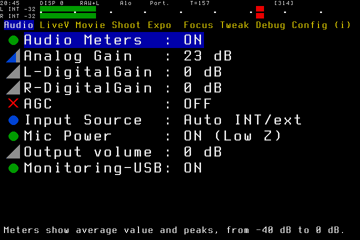

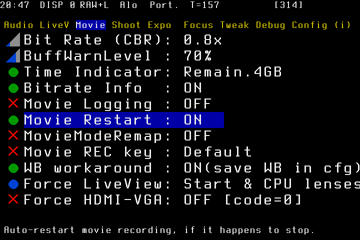






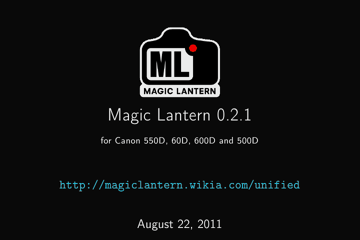
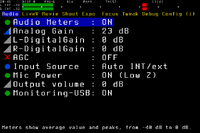



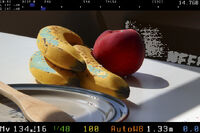

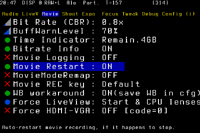



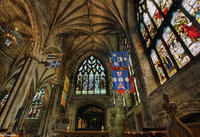
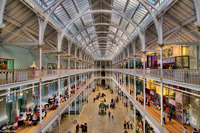
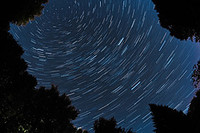
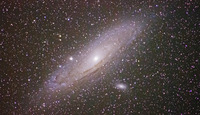
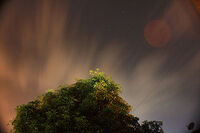

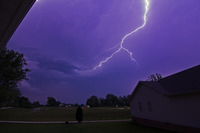


![{\displaystyle 1/4000\cdot 2^{k/8},\;\;k=[135:-1:-8]}](https://services.fandom.com/mathoid-facade/v1/media/math/render/svg/d3f42375be4b3f74703b3b2f4d005d05157e72fa)

